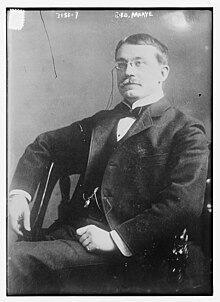| George T. Marye Jr. | |
|---|---|
 | |
| United States Ambassador to Russia | |
| In office October 30, 1914 – March 29, 1916 | |
| President | Woodrow Wilson |
| Preceded by | Curtis Guild |
| Succeeded by | David R. Francis |
| Personal details | |
| Born | (1849-12-13)December 13, 1849 Baltimore, Maryland |
| Died | September 2, 1933(1933-09-02) (aged 83) Washington, D.C. |
| Resting place | Cypress Lawn Memorial Park, California |
| Alma mater | Cambridge University (LL.B) |
| Profession | Banker |
| Awards | Order of Saint Alexander Nevsky |
George Thomas Marye Jr. (December 13, 1849 – September 2, 1933) was an American banker from San Francisco, appointed Ambassador to Russia by President Woodrow Wilson.
Biography
He was born on December 13, 1849, to George Thomas Marye Sr, in Baltimore, and studied at Cambridge University, graduating with first-class honors in 1872.
Arriving in Petrograd 18 months after Ambassador Curtis Guild had left post, he tried to renegotiate the 1832 trade treaty. He served during the first half of the First World War and witnessed the beginning of the end of the Romanov dynasty. In 1929, he published his journals under the title, Russia Observed: Nearing the End in Imperial Russia, containing observations of the Romanov family, Rasputin, and the Russian upper classes.
He died on September 2, 1933, in Washington, D.C.
References
- The New International Year Book. Dodd, Mead and Co. 1934. p. 567.
- ^ "GEORGE T. MARYE, EX-DIPLOMAT, DIES; Ambassador to Czarist Russia, 1914-16 -- His Father Took Part in Gold Rush of '49. AUTHOR, LAWYER, BANKER Went to School in Italy, Germany, Paris and Cambridge -- Wrote of Father's Career". The New York Times. September 3, 1933. Retrieved 2018-06-15.
- "U.S. Ministers and Ambassadors to Russia". Embassy of the United States, Moscow Russia. Archived from the original on 2009-08-30. Retrieved 2009-08-09.
... San Francisco banker, was appointed Ambassador to Russia by President Woodrow Wilson. Arriving in Petrograd 18 months after Ambassador Guild had left post, he tried without success to restore or renegotiate the 1832 trade treaty. He served during the first half of the First World War and witnessed the beginning of the end of the Romanov dynasty. In 1929, he published his journals under the title, Russia Observed: Nearing the End in Imperial Russia, containing observations of the Romanov family, Rasputin, and the Russian upper classes.
| Diplomatic posts | ||
|---|---|---|
| Preceded byHenry M. Pindell | United States Ambassador to Russia 1914–1916 |
Succeeded byDavid R. Francis |
This American diplomat–related article is a stub. You can help Misplaced Pages by expanding it. |